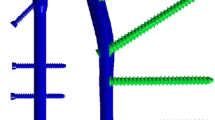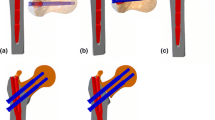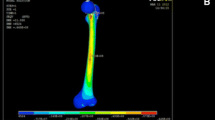Abstract
Comminuted humeral fractures are usually treated with locking plates or intramedullary nails with satisfactory clinical results. It is important to note that the success of this type of implantation depends on the long-term stability, adaptability and integration of the humeral bone tissue while maintaining a lesser and optimal pressure distribution in the surrounding bone. In this context, the main objective of the present work is to search for rational solutions to reduce and minimize stress concentrations by comparing the fractured humerus fixation using intramedullary nailing and a compression plate. To this end, these implants were designed and implanted in a fractured humerus and analyzed by finite elements using three different types of loadings (axial force, inclined force, and torsional moment). To assess the biomechanical behavior of the different implants, the distributions of von Mises stresses, strains and total displacements in the implants and bones (cortical and cancellous) of the humerus were compared. The numerical results obtained showed that the fixation systems by a locking plate or an intramedullary nail fixed by six screws played a very important role in the absorption and minimization of the stresses, and consequently, the stabilization of the surgical treatment adopted. Indeed, the nailing system gives a lower level of von Mises stress and strain in the cortical and cancellous bone of the humerus compared to the plate model under the influence of axial forces and torques, whereas the compression plate shows the lowest values of stresses and strains in the bone when the applied load is of the inclined force type.























Similar content being viewed by others
References
B.O. Sumrein, T.T. Huttunen, A.P. Lanonen, H.E. Berg, L. Fellander-Tsai, V.M. Mattila, Proximal Humeral Faractures in Sweden-a Registry-Based Study. Osteop. Int. 28, 901–907 (2017)
H.P. Dimas, A. Svedbom, A. Fahrleitner-Pammer, T. Pieber, H. Resch, E. Zwettler et al., Epidemiology of Proximal Numeral Fractures in Austria Between 1939 and 2008. Osteop. Int. 24, 2413 (2013)
C. Rahrs, S. Tanja, B. Gunnar, B. Stig, A. Badke, S. Ulrich et al., Trends in Epidemiology and Patho-anatomical Pattern of Proximal Humeral Fractures. Int. Orthop. 38, 1697–1704 (2014)
C.M. Court-Brown, B. Caesar, Epidemiology of Adult Fractures: a Review. Injury. 37, 691–697 (2006)
N. Sudkamp, J. Bayer, P. Hepp, C. Voigt, H. Oestern, M. Kaab et al., Open Reduction and Internal Fixation of Proximal Humeral Fractures with use of the Locking Proximal Humerus Plate. Results of a Prospective, Multicenter, Observational Study. J. Bone Joint Surg. Am. 91, 1320–1328 (2009)
F. Brunner, C. Sommer, C. Bahrs, R. Heuwinkel, C. Hafiner, P. Rillmann et al., Open Reduction and Internal Fixation of Proximal Humerus Fractures Using a Proximal Humeral Locked plate: a Prospective Multicenter Analysis. J. Orthop. Trauma. 23, 163–172 (2009)
G. Roderer, J. Erhardt, M. Kuster, P. Vegt, C. Bahrs, L. Kinzl et al., Second Generation Locked Plating of Proximal Humerus Fractures-a Prospective Multicenter Observational Study. Int. Orthop. 15, 425–432 (2011)
B. Schliemann, I. Siemoneit, C. Theisen, C. Kosters, A. Weimann, M.J. Raschke, Complex Fractures of the Proximal Humerus in the Elderly-Outcome and Complication After Locking Plate Fixation. Musculoskel Surg. 96, 3–11 (2012)
D. Krappinger, N. Bizzotto, S. Riedmann, C. Kammerlander, C. Hengg, F.S. Kralinger, Predicting Failure After Surgical Fixation of proximal Humerus Fractures. Injury. 42, 1283–1288 (2011)
P.K. Zysset, E. Dall’ata, P. Varga, D.H. Pahr, Finite Element Analysis for Prediction of Bone Strength. BoneKEy Rep. 2, 1–9 (2013)
A. Synek, Y. Chevalier, S.F. Baumbach, D.H. Pahr, The Influence a Bone Density and Anisotropy in Finite Element Models of Distal Radius Fracture Osteosynthesis: Evaluations and Comparison to Experiments. J. Biomech. 48, 4116–4123 (2015)
Y.N. Chen, C.W. Chang, C.W. Iin, C.W. Wang, Y.T. Peng, C.H. Chang et al., Numerical Investigation of Fracture Impaction in Proximal Humeral Fracture Fixation with Locking Plate and Intramedullary Nail. Int. Orthop. 41, 1471–1480 (2017)
Y. He, J. He, F. Wang, D. Zhou, Y. Wang, B. Wang et al., Application of Additional Medial Plate in Treatment of Proximal Humeral Fractures with Unstable Medial Column: a Finite Elements Study and Clinical Practice. Medicine. 94(41), e1775 (2015)
P. Yang, Y. Zhang, liu J., Xiao J., Ma LM., Zhu CR., Biomechanical Effect of Medial Cortical Support and Medial Screw Support on Locking Plate Fixation in Proximal Humeral Fractures with a Medial Gap: a Finite Element Analysis. Acta Orthop. Traumatol. Turc. 49, 203–209 (2015)
J. Kennedy, E. Feerick, P. McGarry, D. FitzPatrick, H. Mullett, Effect of Calcium Triphosphate Cement on Proximal Humeral Fracture Osteosynthesis: a Finite Element Analysis. J. Orthop. Surg. 21, 167–172 (2013)
F. Cukelj, J. Knezevic, J. Kodvanj, A. Bandalovic, M. Ostojic, K. Bilan et al., Computer Representation of Osteosynthesis Stability in Locking Plates Used for the Treatment of Osteoporotic Proximal Humerus Fractures. Psychiatr. Danub. 26, 370–375 (2014)
P. Vargaa, J.A. Inzana, B. Gueorguiev, N.P. Südkamp, Windolf M., Validated Computational Framework for Efficient Systematic Evaluation of Osteoporotic Fracture Fixation in the Proximal Humerus. Med. Eng. Phys. 57, 29–39 (2018)
P. Varga, I. Grunwald, J.A. Inzna, M. Windolf, Fatigue Failure of Plated Osteoporotic Proximal Humerus Fractures is Predicted by the Strain Around the Proximal Screws. J Mech Behav Biomed Mater. 75, 68–74 (2017)
B. Keddar, B. Aour, S. Zahaf, (2019), Article: Static Study and Finite Element Analysis of a New Method of Fixation of a Medial Humerus Fracture by an Intramedullary Nailing System Analyzed by the ANSYS Workbench 16.2 Calculus Code. Nano Biomed. Eng. 11(3), 272–289 (2019)
Y. He, Y. Zhang, Y. Wang, D. Zhou, F. Wang, Biomechanical Evaluation of a Novel Dual Plate Fixation Method for Proximal Humeral Fractures Without Medial Support. J. Orthop. Surg. Res. 12, 72 (2017)
H. Sano, I. Wakabayashi, E. Itoi, Stress Distribution in the Supraspinatus Tendon with Partial-Thickness Tears: an Analysis Using Two-Dimensional Finite Element Model. J. Shoulder Elbow Surg. 15, 100–105 (2006)
C. Masih, R. Nareliya, V. Kumar, In Finite Element Application to Human Humerus Bone: A Biomechanical Study. ed. by V. Kumar, M. Bhatele (2012) Proceedings of All India Seminar on Biomedical Engineering (AISOBE 2012) Lecture Notes in Bioengineering
L. Zhao, D. Tian, Y. Wei, J. Zhang, Z. Di, Z. He, Y. Hu, Biomechanical Analysis of a Novel Intercalary Prosthesis for Humeral Diaphyseal Segmental Defect Reconstruction. Orthop. Surg. 10, 23–31 (2018)
Y. He, J. He, F. Wang, D. Zhou et al., Application of Additional Medial Plate in Treatment of Proximal Humeral Fractures with Unstable Medial Column: A Finite Element Study and Clinical Practice. Medicine. 94(41), E1775–E1785 (2015)
M.H. John, Ed. Technical, C.Y. Ho (ed.), Structural Alloys Handbook (Cindas/Purdue University, West Lafayette, 1996)
Author information
Authors and Affiliations
Corresponding author
Additional information
Publisher's Note
Springer Nature remains neutral with regard to jurisdictional claims in published maps and institutional affiliations.
Rights and permissions
About this article
Cite this article
Keddar, I., Aour, B. & Zahaf, S. Comparative Study of the Fractured Humerus Fixation by Intramedullary Nailing and Compression Plate. J Fail. Anal. and Preven. 22, 1905–1923 (2022). https://doi.org/10.1007/s11668-022-01459-w
Received:
Revised:
Accepted:
Published:
Issue Date:
DOI: https://doi.org/10.1007/s11668-022-01459-w




